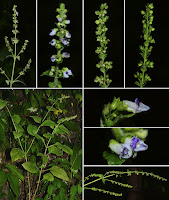 |
| Isodon brevipedunculatus Y.P. Chen & C.L. Xiang, in Chen, Huang, Zhao & Xiang, 2021 |
Abstract
Isodon brevipedunculatus, a new species from southern China, is described and illustrated. The phylogenetic position of the new species within the genus was analyzed based on two nuclear ribosomal DNA regions and an ingroup sampling of about 80% of Asian species of Isodon. The results show that I. brevipedunculatus is recovered in a clade that consists of species mainly with glandular mericarps and that are distributed in the Sino-Japanese region. Combining molecular and geographical evidence, our study reveals that I. brevipedunculatus is most closely related to Isodon amethystoides and Isodon bifidocalyx, but differs from the former in lamina shape, number of flowers per cyme, and peduncle length, and from the latter in lamina indumentum, calyx morphology, and corolla length.
Keywords: Himalaya-Hengduan Mountains region, Isodoninae, Mericarp, Sino-Japanese region
 |
| Isodon brevipedunculatus Y.P. Chen & C.L. Xiang (A) habit; (B) flower; (C) dissected calyx; (D) dissected corolla; (E) pistil; (F) mericarp. Drawn by L. Wang. |
Isodon brevipedunculatus Y.P. Chen & C.L. Xiang, sp. nov.
Diagnosis: The new species is morphologically similar to Isodon amethystoides and I. bifidocalyx, but differs from the former in its broadly ovate to ovate laminae (vs. ovate to lanceolate), 3–7-flowered cymes (vs. 7–15-flowered), and 1–2 mm long peduncles (vs. 1–4 cm long), and differs from the latter in having densely pubescent laminae (vs. subglabrous), flowering calyces slightly 2-lipped to 1/3 of their length with teeth subequal (vs. strongly 2-lipped to 1/2 their length with teeth unequal), erect fruiting calyces (vs. declinate), and corollas ca. 4 mm long (vs. ca. 8 mm long).
Distribution and habitat: Isodon brevipedunculatus is currently known from Guangdong Province and Hunan Province in southern China (Fig. 4). It can be found in forests or on grassy slopes at altitudes of 600–1250 m.
Etymology: The specific epithet refers to the short peduncles of the new species, as compared to one of the most similar species, Isodon amethystoides.
Chinese name: Duan Geng Xiang Cha Cai (短梗香茶菜).
Ya-Ping Chen, Cun-Zhong Huang, Yue Zhao and Chun-Lei Xiang. 2021. Molecular and Morphological Evidence for A New Species of Isodon (Lamiaceae) from southern China. Plant Diversity. 43(1); 54-62. DOI: 10.1016/j.pld.2020.06.004




